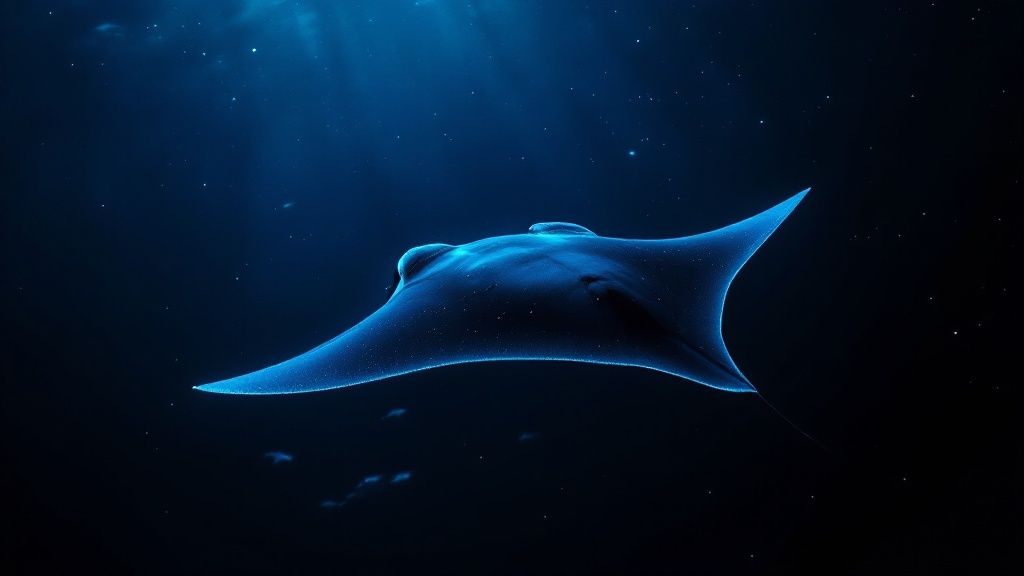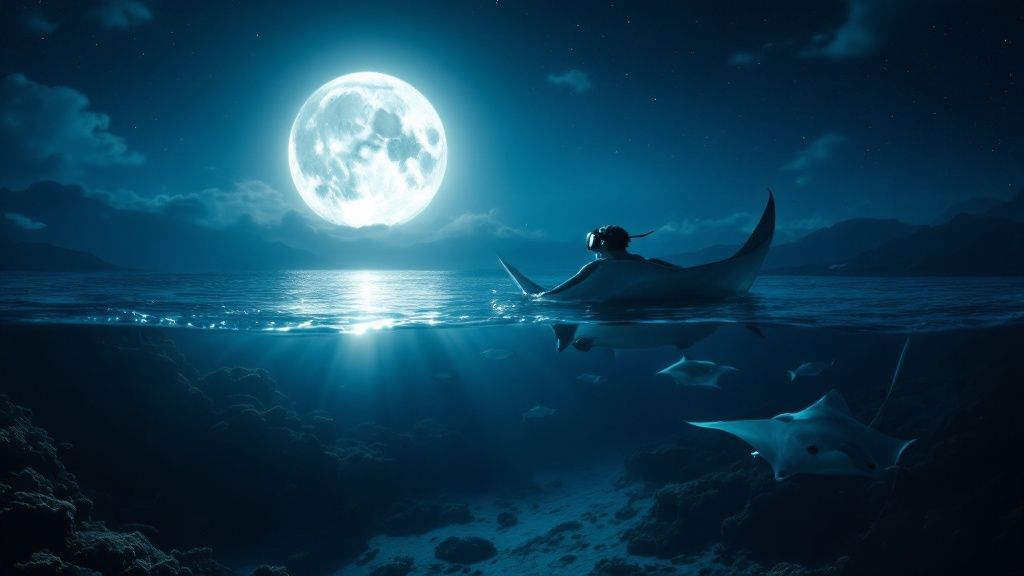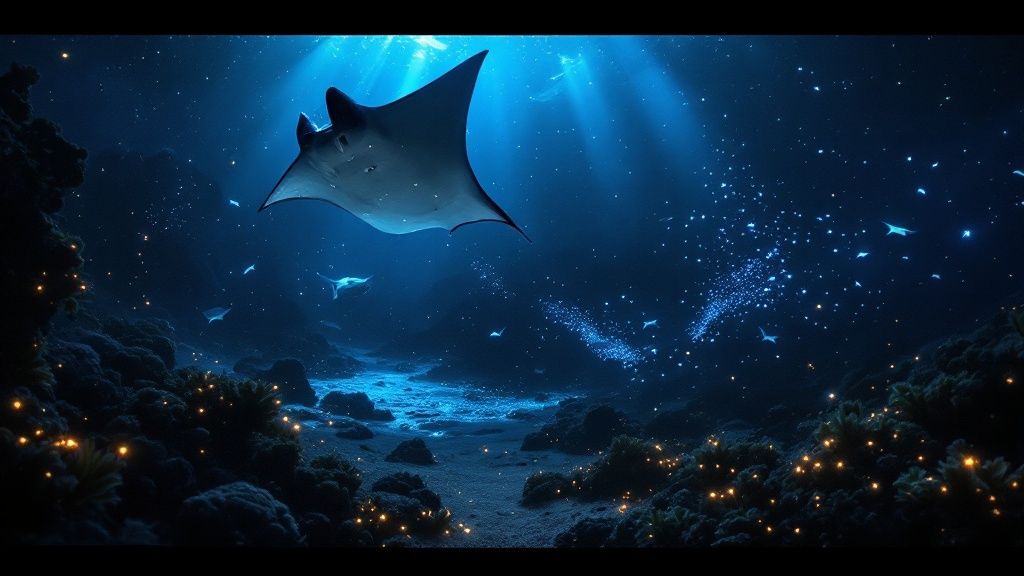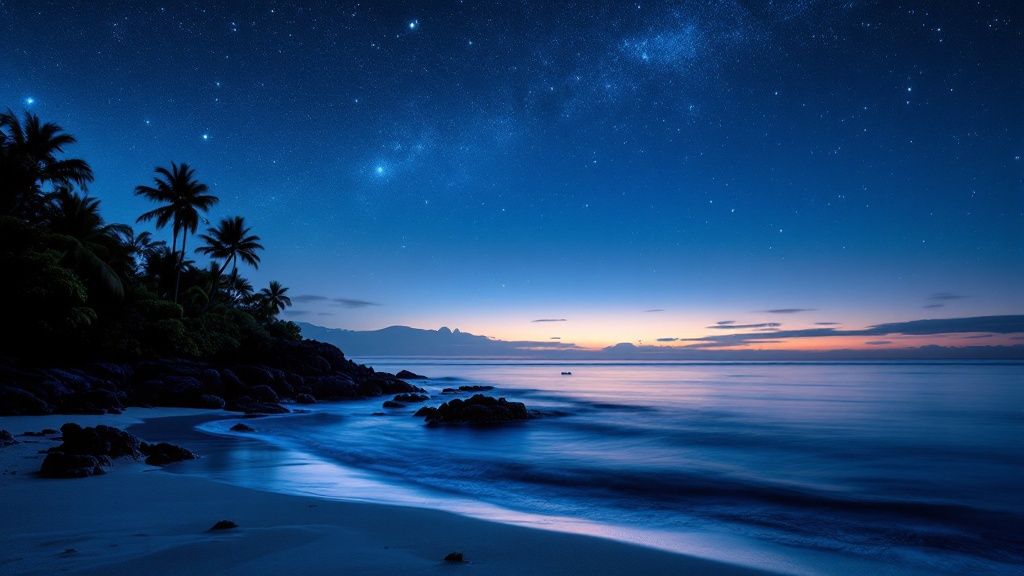Manta Ray Night Snorkel Kona: Unforgettable Adventure
- Byron
- Apr 27
- 13 min read
The Magic of Manta Ray Night Snorkeling in Kona

Imagine floating in the warm ocean, enveloped by darkness, as massive manta rays glide beneath you, illuminated by dive lights. This is the magic of manta ray night snorkeling in Kona, an experience captivating thousands yearly. It's an accessible adventure, perfect for anyone with basic swimming skills wanting a close encounter with these gentle giants. This unique experience creates a sense of wonder and a deeper connection with the marine world.
This unforgettable adventure is more than just a brief moment; it's a carefully planned interaction between humans and nature. Tour operators have adopted sustainable practices that benefit both visitors and the manta rays. They use special lighting techniques to attract plankton, the manta rays' main food source, creating a "campfire of light."
This approach minimizes environmental disruption while maximizing viewing opportunities. Many operators use a central light source, like a submerged board with lights, as a focal point for the plankton and manta rays. This allows snorkelers to observe the feeding from a designated area.
The Kona coast provides an ideal habitat for these mesmerizing creatures. The volcanic underwater landscape creates sheltered bays and gentle slopes perfect for manta ray feeding grounds. The nutrient-rich waters support large plankton populations, attracting these majestic filter feeders to locations like Keauhou Bay, home to the famed "Manta Village."
Approximately 80,000 people participate in manta ray night snorkeling in Kona every year, making it a significant tourist attraction and a contributor to the local economy. This thriving ecosystem is supported by Kona's unique natural elements, offering snorkelers an incredible view of these gentle giants feeding on plankton. Learn more about the thriving manta ray population here: Snorkeling with Manta Rays Kona.
Choosing Your Manta Ray Adventure
Several reputable tour operators offer manta ray night snorkeling experiences in Kona. Companies like Kona Honu Divers and Kona Snorkel Trips offer a variety of options, including small group tours and private charters. Captain Cook Snorkeling Tours also provides excellent options. Choosing the right operator can enhance your experience, from boat size and amenities to the guides' knowledge and commitment to sustainable practices.
For more information, consider checking out the Manta Ray Night Snorkel Hawaii Blog. It offers a wealth of information on what to expect during your adventure, choosing the right tour operator, and important safety tips. This will help ensure a memorable experience with these majestic creatures. You can also visit Manta Ray Night Snorkel Hawaii for comprehensive information on their tours.
Why Kona's Waters Are Perfect for Manta Encounters

Kona, Hawaii, is a world-renowned destination for manta ray encounters. But what makes these waters so attractive to these gentle giants? The secret lies in the unique blend of geological features and a thriving ecosystem.
Ancient volcanic activity sculpted Kona's underwater landscape. The resulting gentle slopes and sheltered bays create ideal manta ray feeding grounds. These bays trap plankton, the manta rays' primary food source, providing a consistent feast.
Local currents further enhance this natural plankton buffet. This abundance of food draws manta rays to specific spots like Manta Village and Manta Heaven, making them predictable and reliable locations for night snorkeling excursions.
The Impact of Kona's Ecosystem
This rich ecosystem is more than just plankton. It supports a vibrant array of marine life, fostering a balanced environment crucial for the health and abundance of the resident manta ray population.
Unlike many locations with seasonal manta ray sightings, Kona boasts a year-round resident population. This underscores the consistently favorable conditions these waters offer. For more information about tours and services, visit Our sitemap.
Kona's Remarkable Manta Ray Sightings
Manta ray night snorkeling in Kona boasts impressive success rates, with sightings between 85-90%. This consistency is attributed to the unique underwater topography, including gentle slopes and protected bays, providing an ideal feeding environment. The nutrient-rich waters support a vast plankton population, making spots like Manta Village and Manta Heaven reliable feeding grounds. Jack's Diving Locker Manta Ray Report highlights these impressive statistics. Organizations like Manta Ray Advocates Hawaii have meticulously documented individual manta rays and their conditions to better understand their behavior and habitat.
Seasonal Variations and Viewing Locations
While manta rays grace Kona's waters year-round, different seasons subtly influence their behavior. Calmer waters during warmer months can offer enhanced visibility. However, each season provides a unique experience, and manta ray encounters remain consistently rewarding.
Selecting the right viewing location enhances your experience. Each spot has unique characteristics. Some locations attract larger groups of mantas, while others are better suited for less experienced snorkelers. Kona Snorkel Trips provides excellent information on various locations. You can also check out Kona Honu Divers and Captain Cook Snorkeling Tours. For booking options and additional information, visit Manta Ray Night Snorkel Hawaii.
The following table compares some of the best viewing locations in Kona:
Prime Manta Ray Viewing Locations in Kona
Location | Average Mantas | Depth | Best For | Access Method |
|---|---|---|---|---|
Manta Village | 10-20 | 10-30ft | Large groups, all experience levels | Boat |
Manta Heaven | 5-15 | 20-40ft | Experienced snorkelers | Boat |
Keauhou Bay | 2-5 | 15-25ft | Beginners, calm waters | Boat, shore |
Makako Bay | Varies | 10-20ft | Experienced snorkelers, daytime viewing | Shore |
This table summarizes the key differences between the locations, helping you choose the best spot for your experience level and desired manta ray encounter.
The thriving manta ray tourism in Kona demonstrates the positive relationship between tourism and conservation. By appreciating and protecting this delicate ecosystem, we can ensure future generations continue to enjoy these magnificent encounters.
The Complete Manta Ray Night Snorkel Experience

Your manta ray night snorkel Kona adventure begins with the excitement of knowing you'll soon witness these gentle giants. Preparing for this unique experience is part of the fun. This guide walks you through a typical evening, setting realistic expectations for this incredible encounter.
From Shore to Sea
After choosing a reputable tour operator like Kona Honu Divers, Manta Ray Night Snorkel Hawaii, or Kona Snorkel Trips, you’ll meet near the harbor. A short boat ride takes you to the viewing site. This is the perfect time to chat with your guides and learn about the local manta rays.
The "Campfire of Light" and Plankton Attraction
At the site, operators use bright lights to attract plankton, the manta rays' primary food source. This creates a captivating "campfire of light" on the surface. This illuminated area becomes a feeding zone, drawing the manta rays closer to the waiting snorkelers. Some operators use a central light attached to a floating platform, providing a stable viewing spot.
Entering the Water and Floating with Giants
Before you enter the water, guides provide a comprehensive safety briefing and instructions. Wetsuits are typically available and recommended to prevent chilling, even in warm water. Many tours also offer flotation devices, like pool noodles, to help you conserve energy and stay afloat. This makes the experience enjoyable for all swimming abilities.
Once in the water, position yourself near the light, holding onto the platform or using a flotation device. Then, the magic unfolds. Manta rays emerge from the darkness, their impressive forms illuminated by the lights. They perform graceful underwater dances as they feed, often swimming incredibly close.
The Sensory Experience: Beyond Sight
The manta ray night snorkel is more than just a visual experience. It engages all your senses. The sounds of the ocean at night, the gentle splashes of the mantas, and their occasional calls create a unique ambiance. Floating in the dark ocean surrounded by these gentle giants is truly surreal.
Addressing Common Concerns
Many people feel anxious about night snorkeling. However, experienced guides and proper preparation alleviate these worries. Guides ensure everyone's safety and comfort in the controlled environment of the viewing area, minimizing any potential risks.
Maximizing Your Encounter Time
Manta ray sightings are common in Kona. To maximize your viewing time, stay calm and still in the water. This prevents startling the manta rays, encouraging them to stay longer. Following your guide's instructions about light use and positioning enhances your viewing experience.
Beyond the Snorkel: Post-Encounter Reflections
Back on the boat, often with warm drinks and snacks, you can discuss your experience with others and reflect on the magic. The memories of the manta rays' graceful movements and close encounters will stay with you long after your trip. You might be interested in: Manta Ray Night Snorkel Kona Hawaii Tours for booking information. Also check out Captain Cook Snorkeling Tours for additional insights.
Transforming Hesitant Ocean Visitors
This experience often transforms even those hesitant about the ocean. The close interaction with these gentle creatures creates a sense of wonder and a connection to the marine world. It inspires a deeper appreciation for ocean conservation. See our Manta Ray Night Snorkel Blogs for more about this unforgettable adventure.
Selecting Your Perfect Manta Ray Adventure Guide

Not all manta ray night snorkel tours in Kona are the same. Choosing the right tour operator can significantly enhance your experience. This guide helps you understand the key factors to consider when selecting a tour.
Group Size: Finding the Right Balance
Group size matters when it comes to manta ray viewing. Smaller groups offer a more intimate experience, allowing for personalized attention from guides. Larger groups might be more budget-friendly, but they can feel crowded. This can detract from the peaceful ambiance of observing these gentle creatures.
Vessel Design: Comfort on the Water
The boat itself is a key part of your tour. A stable vessel is important, especially if you're prone to seasickness. Look for boats with viewing platforms designed specifically for manta ray observation. Amenities like restrooms and comfortable seating can also add to your enjoyment.
Amenities and Inclusions: The Added Touches
Consider the extras that can enhance your manta ray night snorkel adventure. Wetsuit rentals are often essential for staying warm in the water. Flotation devices can help less confident swimmers relax and enjoy the experience. Some operators even include snacks and drinks.
Conservation Practices: Protecting the Rays
Choosing a tour operator committed to conservation is crucial. Look for providers actively involved in manta ray protection efforts. This ensures your tourism dollars contribute to preserving these magnificent animals for future generations.
Departure Location and Cancellation Policies: Planning Ahead
Think about the departure location's convenience and the operator's cancellation policy. Some locations offer calmer waters and shorter travel times. A flexible cancellation policy is important in case of unforeseen circumstances.
Local Expertise: An Insider's Perspective
Locally-owned tour operators often bring unique insights. Their deep knowledge of the area and manta ray populations can enhance your experience. Local guides often share fascinating stories, adding depth and meaning to your encounter.
Premium vs. Budget: Weighing Your Options
Consider the value of premium versus budget tours. Premium tours may offer high-quality equipment, smaller group sizes, and experienced guides. Budget-friendly options can still be memorable, particularly if you are comfortable with larger groups and basic amenities.
To help you compare, we've compiled a table highlighting some popular tour operators in Kona:
Top Manta Ray Tour Operators Comparison
A detailed comparison of popular manta ray night snorkel tour operators in Kona, highlighting their offerings, prices, and unique features.
Tour Operator | Group Size | Duration | Price Range | Inclusions | Special Features |
|---|---|---|---|---|---|
Varies | Varies | Varies | Varies | Personalized service, high safety standards | |
Varies | Varies | Varies | Varies | Experienced guides, focus on marine conservation | |
Varies | Varies | Varies | Varies | Small group sizes, personalized attention | |
Varies | Varies | Varies | Varies | Various tour options |
This table provides a starting point for your research. Remember to visit the operators' websites for the most up-to-date information.
Choosing the Right Operator for You
Selecting the perfect operator depends on your individual priorities. What kind of group size do you prefer? How important are onboard amenities? Answering these questions will help you narrow down your options.
Making Your Decision
Research various operators and read reviews. Look for companies with a strong track record. Don't hesitate to contact operators directly to ask questions and gain a better understanding of their operations.
Conservation Success: Protecting Kona's Gentle Giants
The manta ray night snorkel in Kona isn't just a thrilling activity; it represents a significant conservation triumph. Years of dedicated work by researchers and conservationists have transformed Kona into a true sanctuary for these graceful creatures.
Identifying and Tracking Kona's Mantas
A cornerstone of Kona's manta ray conservation is the detailed identification and tracking of individual animals. Each manta has a unique spot pattern on its underside, similar to a fingerprint. Researchers use these patterns to catalog each manta, giving them names like "Big Bertha," and monitor their health, behavior, and movements. This precise tracking provides valuable data for understanding population dynamics and creating effective conservation strategies.
The Positive Impact of Tourism on Conservation
Tourism has surprisingly played a beneficial role in manta ray conservation. Growing public interest in these animals has generated funding for research and protective measures. Many tour operators contribute a portion of their profits to conservation organizations, directly supporting the protection of the mantas and their environment. The presence of tourists also encourages the implementation and enforcement of regulations that safeguard these gentle giants.
Understanding Manta Behavior Through Research
Ongoing research in Kona continues to expand our knowledge of manta ray behavior. These studies explore several key areas:
Feeding Behavior: Researchers observe how mantas feed on plankton, examining their dietary preferences and how they react to the light sources used by tour operators.
Reproduction Cycles: Studying manta ray reproduction helps scientists understand breeding patterns and ensure healthy population growth.
Migration Patterns: Tracking manta ray movements helps identify crucial habitats and migration routes, informing the establishment of protected areas.
Organizations like Manta Ray Advocates Hawaii have been instrumental in data collection. Since 2009, they have diligently documented manta ray sightings, recording individual characteristics, locations, and health. This data sheds light on manta ray travel patterns and predicts sighting probabilities. For more detailed statistics, visit their website: Manta Ray Advocates - Manta Ray Statistics. You can also find more information on All blog posts.
Citizen Science: Contributing to Conservation
Visitors can participate in citizen science initiatives. Many tour operators encourage guests to share their photos and videos of identified manta rays, contributing to the growing database. This allows tourists to become active participants in conservation, strengthening their connection with these remarkable animals.
The Future of Manta Ray Conservation
Kona's ongoing conservation efforts serve as a global model. Through continued research, responsible tourism, and public engagement, we can ensure these gentle giants thrive for generations to come. The manta ray night snorkel in Kona offers not only a memorable experience but also a powerful message of hope for our oceans. For responsible tour options, consider Captain Cook Snorkeling Tours, Kona Honu Divers, Manta Ray Night Snorkel Hawaii, or Kona Snorkel Trips.
Essential Preparation for Your Manta Ray Adventure
Getting ready for your manta ray night snorkel adventure in Kona involves more than just booking the tour. Proper planning ensures a comfortable and unforgettable experience. This section covers the key steps to take before you even board the boat.
Physical Preparation: Setting Yourself Up for Success
Staying hydrated is vital for a pleasant snorkeling experience. Dehydration can worsen seasickness and make you tire more easily. Begin hydrating a day or two before your tour and drink plenty of water on the day of the adventure.
What you eat beforehand also matters. Skip heavy, greasy foods that might upset your stomach. Choose light, digestible meals instead. This will help you feel your best out on the water.
Motion sickness is a common issue with ocean activities. If you are prone to seasickness, take precautions. Over-the-counter medications like Dramamine or Bonine can be helpful. Motion sickness patches or wristbands are other options.
What to Wear and Bring: Practical Tips
The right clothing will maximize your comfort. Even in Hawaii's warm weather, the ocean can get cool at night. Dressing in layers or bringing a light sweater to wear after your snorkel is a good idea.
Consider packing these essentials:
Towel: For drying off after your time in the water.
Change of clothes: Dry clothes will make the trip back to your accommodations much more pleasant.
Personal snorkel gear (optional): While most tour operators provide equipment, your own mask and snorkel offer a more customized fit.
Reef-safe sunscreen: Protecting your skin while also preserving the coral reef is essential.
Wetsuit Rentals: Staying Warm in the Water
Wetsuits are available for rent and provide important insulation in the water. Even if you don't usually get cold easily, a wetsuit is a good idea, as the water can feel significantly colder at night. A wetsuit can dramatically improve your comfort, allowing you to fully enjoy the experience without getting chilled. For more details on manta ray night snorkel tours, check out Manta Ray Night Snorkel Hawaii.
Accommodations for Different Swimming Abilities
Manta ray night snorkeling is suitable for all swimming levels. If you are not a strong swimmer, don't worry. Most tours offer flotation devices like pool noodles or life vests. These aids help you stay afloat and conserve energy so everyone can enjoy the experience.
Special Considerations for Families and Older Visitors
Families with young children can definitely participate in this magical experience. Make sure children are comfortable in the water and follow safety instructions closely. For older visitors or those with mobility issues, inform the tour operator beforehand. Many can provide extra assistance and make accommodations to ensure a comfortable and memorable experience for everyone.
Mental Preparation: Embracing the Experience
Embrace the unique opportunity of being in the ocean at night. If you are feeling a little nervous, focus on taking deep breaths and relaxing your body. Remember that experienced guides are there to ensure your safety and comfort. Trust their expertise and let yourself be captivated by the wonder of the manta rays. The magic of this encounter truly transforms even the most hesitant visitors. Consider booking your adventure with reputable operators like Kona Honu Divers or Captain Cook Snorkeling Tours. For a specialized manta ray tour, check out Manta Ray Night Snorkel Hawaii and Kona Snorkel Trips.
Capturing Unforgettable Manta Ray Moments
Before your manta ray adventure, prioritize safety. A quick review of snorkeling safety tips is always a good idea. Now, let's explore how to capture the magic of your Kona manta ray night snorkel. Documenting this special encounter has its challenges, but the right preparation ensures lasting memories.
Choosing the Right Equipment: From Smartphones to Professional Cameras
Capturing quality underwater images in low light requires specific gear. GoPro cameras are a popular choice, known for their durability and underwater housing options. For serious underwater photographers, dedicated housings for DSLR or mirrorless cameras offer the best image quality. Smartphone housings provide a budget-friendly option. Keep in mind, however, that low-light conditions may limit image quality.
Mastering the Settings: Capturing Movement and Light
Successfully photographing manta rays at night depends on understanding your camera settings. With GoPros and other action cameras, try different video modes and frame rates. A higher frame rate helps capture the manta rays' fluid movements without blurring. If you're using a DSLR or mirrorless camera, a fast lens with a wide aperture (like f/2.8) helps maximize light. Carefully adjust your ISO settings to find a balance between brightness and minimizing noise.
Lighting Techniques: Respecting the Rays While Illuminating Your Shots
Lighting is key for capturing manta rays. However, responsible light use is essential. Never use flash. It can startle the rays and disrupt their natural behavior. The dive lights provided by tour operators are designed to attract plankton and usually provide enough illumination to capture the mantas as they feed. Positioning yourself near these lights improves visibility for both you and your camera.
Balancing the Moment and the Documentation
While capturing the encounter is exciting, remember to be present. Savor the experience of observing these gentle giants. Don't get so focused on documentation that you forget to appreciate the moment. Photography should enhance your memories, not replace them.
Storage and Backup: Protecting Your Precious Memories
Protecting your images and videos after capturing them is important. Bring extra batteries and memory cards. After your trip, back up your files in multiple locations. Consider cloud storage, external hard drives, or even printing physical copies. This protects against data loss and makes it easier to relive the experience.
Sharing and Conservation: Beyond Social Media
Sharing your photos and videos is a great way to relive your manta ray night snorkel and inspire others. Go beyond basic social media posts. Create short videos with music and narration to add a personal touch. Share your memories with friends and family.
Consider using your images for conservation efforts. Submitting photos to research organizations like Manta Ray Advocates Hawaii contributes valuable data. Your images can help identify individual manta rays and monitor the health of the population.
Booking Your Unforgettable Manta Ray Night Snorkel Kona Experience
Ready for this adventure? Book your Manta Ray Night Snorkel Kona Hawaii Tour today! Manta Ray Night Snorkel Kona Hawaii Tours offers a personal experience that prioritizes safety and respect for these magnificent creatures. Small group sizes, experienced guides, and a focus on sustainable practices ensure a magical encounter you'll treasure forever.
Comments